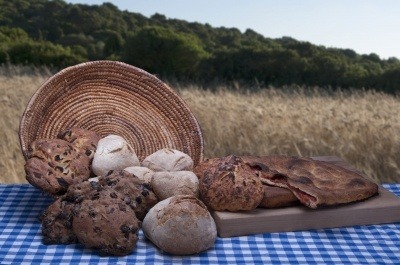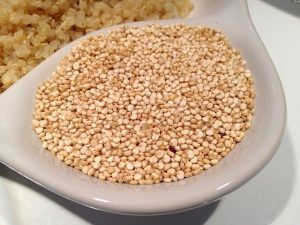
The Incas, many moons ago ate quinoa as a staple – the ‘mother grain’ as they referred to it because it grew extremely well in the Andes. It is according to the United Nations a key crop and a rich source of protein as well as being a valuable source of micronutrients. This grain o more accurately pseudograin contains essential amino-acids, dietary fibre, various metals such as iron, magnesium and phosphorous as well as numerous other bioactives (Chauhan et al., 1992).
It suits a gluten-free diet.
The plant is a member of the amaranth family. It is widely grown in Peru, Bolivia, Ecuador, Chile and Argentina (Bhargava et al., 2006).
Quinoa (Chenopodium quinoa WILLD.) was recognised in the 70’s for its high quality protein content, and especially its lysine levels which made it superior in the nutritional sense to wheat. The protein level is between 12 and 23% w/w (Ruales & Nair, 1992; Ando et al., 2002). Unfortunately, its lack of gluten makes its unsuitable for bread making unless mixed with wheat.
In Bolivia for example quinoa flour is mixed to 5% into breads and other baked goods. It is a good mixer with other cereal flours because of the high protein levels. The protein is albumin and chenopodin (Brinegar and Goundan, 1993; Brinegar et al., 1996; Abugoch et al.,2008).
Nutritional Value
The nutritional content in 1 US cup (185 grams) of cooked quinoa (nutrition data.self.com):
- Protein: 8 grams.
- Fibre: 5 grams.
- Manganese: 58% of the recommended daily allowance (RDA).
- Magnesium: 30% of the RDA.
- Phosphorus: 28% of the RDA.
- Folate: 19% of the RDA.
- Copper: 18% of the RDA.
- Iron: 15% of the RDA.
- Zinc: 13% of the RDA.
- Potassium 9% of the RDA.
- Over 10% of the RDA for vitamins B1, B2 and B6.
- Small amounts of calcium, B3 (niacin) and vitamin E.

Compounds In Quinoa
There are many compounds in this grain which deserve considerable attention. A number of them are antioxidants of which the flavonoids play a predominant role. Ones that come to mind are quercetin and kaempferol
Human weaning foods use germinated quinoa flour (Atwell et al., 1988) because they generate products with reduced viscosity.
The grain contains saponins – triterpenoidal glycosides which can halt uptake of nutrients and irritate the small intestine (Moges et al., 2001). Saponins add bitterness to quinoa which limits the sensory uptake of the grain but given that 34% of this bitterness is found in the hulls, washing in water or dehulling reduces the sensory impact (Reichert et al., 1986; Chauhan et al., 1992).
Milling the grain to flour appears to cause the protein content to drop substantially and is associated with the removal of bran which amounts to 40% of the dehulled seed and 62% of the total protein (Chauhan et al., 1992).
Cooking With Quinoa
Rather like cous-cous and rice, it is prepared in a similar way. It needs to be washed first though to remove any bitter coatings which contain saponins. It absorbs water readily and swells to four times its size. It is usually eaten ‘al dente’. It is often combined with other grains to add variety of crunch.
A number of manufacturers are investigating quinoa processing and cooking in product development. A list can be made available of processors in this field.
References
Abugoch, L., Romero, N., Tapia, C., Silva, J. & Rivera, M. (2008). Study of some physicochemical and functional properties of quinoa (Chenopodium quinoa Willd.) protein isolates. J. Agric. Food Chem., 56, pp. 4745–4750.
Ando, H., Chen, Y., Tang, H., Shimizu, M., Watanabe, K. & Miysunaga, T. (2002). Food components in fractions of Quinoa seed. Food Science Technology Research, 8, pp. 80–84.
Atwell, W.A., Hyldon, W.G., Godfret, P.D., Galle. E.L., Sperber, W.H., Pedersen, D.C., Evans, W.D. & Rabe, G.O. (1988). Germinated quinoa flour to reduce the viscosity of starchy foods. Cereal Chem, 65, pp. 508-509.
Bhargava, A., Shukla, S. & Ohri, D. (2006). Chenopodium quinoa – an Indian perspective. Industrial Crops Products, 23, pp. 73–87.
Brinegar, C. & Goundan, S. (1993). Isolation and characterization of chenopodin, the 11S seed storage protein of quinoa (Chenopodium quinoa). J. Agric. Food Chem., 41, pp. 182–185.
Brinegar, C., Sine, B. & Nwokocha, L. (1996). High-cysteine 2S seed storage proteins from quinoa (Chenopodium quinoa). J. Agric. Food Chem., 44, pp. 1621–1623.
Chauhan. G.S., Eskin, N.A.M. & Tkachuk, R. (1992). Distribution of nutrients and antinutrients in quinoa (Chenopodium quinoa WILLD.) seed fractions. Cereal Chem., 69 pp. 85-88.
Inness, R. (1989). Quinoa’s comeback. IDRC Reports, Vol. 18(2), pp. 22-23
Galwey, N.W., Leakey, C.L.A., Price, K.R., Fenwick, G.R. (1990). Chemical composition and nutritional characteristics of quinoa (Chenopodium quinoa Willd.). Food Sci and Nutr 42F pp. 245-261.
Mahoney, A.W., Lopez, J.G. & Hendricks, D.G. (1975). An evaluation of protein quality of quinoa. J. Agric. Food Chem, 23, pp. 190-193
Moges Woldemichael, G., Wink, M. (2001). Identification and biological activities of triterpenoids saponins from Chenopodium quinoa. J. Agric. Food Chem., 49, pp. 2327–2332
Ranhotra, G.S., Gelroth, J.A., Glaser, B.K., Lorenz, K.J., Johnson, D.L. (1993). Composition and protein nutritional quality of quinoa. Cereal Chem. 70(1) pp. 303-305
Reichert, R.D., Tatarynovich, J.E. & Tyler. R.T. (1986). Abrasive dehulling of quinoa (Chenopodium quinoa): Effect of saponin content as determined by an adapted haemolytic assay. Cereal Chem., 63 pp. 471-475.
Ruales, J. & Nair, B. (1992). Nutritional quality of the protein in quinoa (Chenopodium quinoa, Willd.) seeds. Plant Foods for Human Nutrition, 42, pp. 1–11.
Leave a Reply